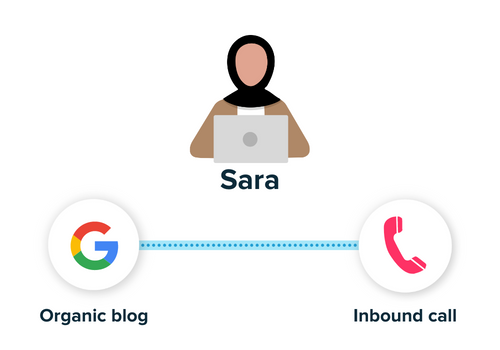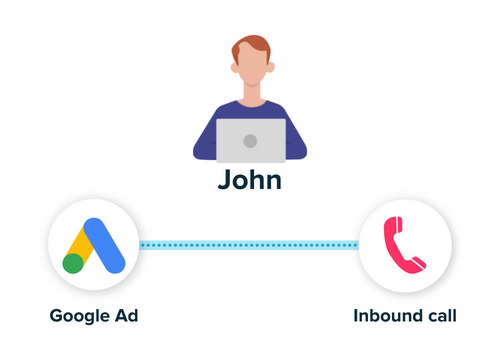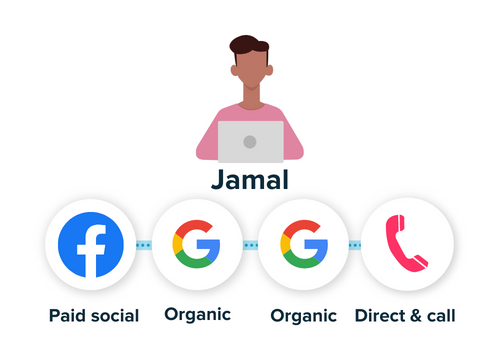Want the 411 on exactly how to prove marketing impact on offline sales? Read our complete call tracking guide to see how you can link inbound calls back to marketing activity.
Despite the surge in popularity of live chat tools, calls still remain a highly popular way for users onsite to convert.
In fact, we found that 50% of marketers use a phone number on site to drive inbound leads.
The issue you face is connecting the ringing of the phone back to website activity.
Sounds impossible right?
It isn’t.
Despite 62% of those using calls struggling to track them, we’re here with the complete lowdown on exactly how to track your calls.
Stick around to learn:
Let’s get stuck in.
If you’re a business, then call tracking goes beyond caller ID.
Call tracking is a technology that allows you to track who is calling you and how they found your business.
So what does call tracking for a business involve?
Well, the main incentive of call tracking is the ability to correlate inbound calls and leads to your marketing channels and activities.
While you might be tracking click-to-call to get an idea of inbound call volume, what you can’t see is how your marketing is driving these calls.
Call tracking is the missing piece that can allow businesses to relate an inbound call back to sessions on your website.
There are a number of providers of call tracking out there. But most work in a similar sort of way.
🚀Pro Tip
Ruler is a leading provider of call tracking and attribution. Learn exactly how Ruler’s call tracking works.
Let’s break it down using a few examples:
Sara visits your website for the first time via an organic visit. She had searched a particular keyword that you rank number one for, and decided to click your link.
She has a read of your blog and decides it looks like a good fit.
Looking at your site, she spots a number top right so chooses to give it a call.

She copies and pastes the number into her dial pad and it starts ringing.
A sales operative picks up and has a good chat with Sara on her current needs and if the product is a good fit.
She decides that it is, and she converts right away, closing into a sale.
Now, your sales operative only has the information from the call.
She has no way of knowing where Sara came from, other than… via your phone number.
Call tracking tools use dynamic numbers to assign unique numbers to each visitor to your site.
Related: What is dynamic number insertion
That means when Sara landed on your site, she was shown a unique phone number that only she can see.
When she called, your call tracking software would register the call.
And, when the sales operative added the relevant information into your CRM, it would be updated accordingly to link Sara’s website activity to her sales details.
Not every lead will click into your site and convert.
Some might convert within Google’s search results.
Take John.

He searched for a specific product in his area and your Google Ad popped up.
He’s already done his research so he knows what he’s looking for and decides to call. Your Google Ad has a call extension so he clicks that number and his dial pad opens up automatically.
The same principle applies to this scenario.
Instead of a unique number being applied per person, you instead apply a unique number per ad campaign.
This means that you can still isolate John from a call via a different source, for example via a Google My Business page view.
It also means that you can accurately attribute that call to your Google Ad campaign.
Not all leads click and convert right away.
If only!
Some go on long, complicated customer journeys.
Related: Complete guide to customer journey stages
Take Jamal for example.

He’s visited your website a number of times now.
On his fourth visit to your site, he finally decides to call your business.
On this particular visit, he came via a direct search.
However, this isn’t an accurate way to attribute Jamal as a lead.
With the right call tracking tool, you can instead attribute him to his entire customer journey meaning you’ll get a full view of every touchpoint.
This means you can see that paid social drove Jamal’s first visit to your site, but that the direct session is where he converted.
This is really useful information to have as a marketer as you can better understand the role each channel and touchpoint plays.
Some of the examples above wouldn’t be totally trackable in most call tracking tools.
For a full view of leads through the full customer journey, you would need to invest in a marketing attribution tool.
Related: Complete guide to marketing attribution
Marketing attribution is the process of assigning credit to touchpoints based on their influence on revenue generation.
💡Pro Tip
When you’ve invested in marketing attribution, you can also forward all of your lead and revenue data to the tools you use most. It means you can log into tools like Google Analytics and see revenue and leads highlighted next to channels, campaigns and even content.
How to track phone calls in Google Analytics
Attribution works the same as a call tracking tool but instead, it tracks every single lead conversion point, not just calls.
That’s forms and live chat sessions too.
It tracks users from the first time they visit your site and it goes beyond them closing into a won sale too.
⚡️Pro Tip
Ruler Analytics is a leading marketing attribution tool that can help you make more sense of your marketing data. Learn more about what you can learn from Ruler, or get stuck in by booking a demo.
Phone call tracking isn’t difficult to set up. But, there are a number of providers out there so choosing can be tricky. So remember, you need to consider what key features you’re looking for and what problem you’re trying to solve.
Here are some key features to consider when weighing up your call tracking service options:
Dynamic number insertion is the cornerstone to a good phone call tracking service.
You’ll be given a pool of numbers which your website will feature.
For each new session, a unique number will display allowing you to track each individual call to its source.
This data will eliminate guesswork when you’re reporting on your marketing’s success for lead generation down the line.
Call recording is an essential tool to any team.
Not only will call tracking allow you to determine lead quality for inbound calls, but it will also help you to identify training opportunities for your sales or customer service team.
Having call recording be a part of your chosen service will support you in efforts to better align your teams.
Related: Complete guide to achieving sales and marketing alignment
While phone call tracking is a great start to understanding your leads and how marketing is impacting them, it only brushes the surface.
With call tracking, you can get a better idea of where your calls are coming from, but what about other conversion types like:
Marketing attribution is a complementary tool to phone call tracking that allows you to track each and every touchpoint.
No matter if a user fills a form, enters a live chat, or calls you, marketing attribution software will track and store that data. And even better, it can fire the data you need, where you need it, whether that’s to your CRM or apps like Google Analytics.
💡 Pro Tip
We’re kind of experts when it comes to attribution… But, if you’re not 100% sure what attribution is or how you can utilise it, then you’re in luck.
Read our full blog on marketing attribution, the model types and more.
Now you’ve found your chosen provider, setting up your call tracking should be easy.
Here at Ruler, getting started is simple.
We can walk you through our call tracking and marketing attribution tool via a demo, and then we’ll work with you to help you get set up.
Once your numbers are set up, and you’ve added a small piece of code to your website, you’re ready to go!
Once you’ve integrated Ruler Analytics (or another call tracking solution) into your marketing stack, you’re ready to go.
Remember, Ruler will do all the heavy lifting for you when it comes to tracking, evidencing and optimising your marketing.
All you need to do is head over to the dashboard to see your call data pull through.
👉 Book a demo to see our reports in action
Our dashboard allows you to view your inbound calls in real time.
You’ll find vital information such as caller name, tracking number dialled, source of the call, caller phone number and location, and any PPC keywords your caller used to find your business online.
You can also playback the calls, to understand the lead quality or monitor your sales pitches.
Whether you’re in your CRM and looking at where your leads have come from, or if you’re in GA looking to see what campaigns are bringing in the most revenue; we can add all the data you need to properly link your sales data to your marketing data.
That means you can prove your marketing ROI, and optimise your campaigns and marketing efforts to what you can see works best.
Interested? Book a demo with our team to find out more about how our software can help you. Or, sign up for Attribution Academy, our free e-learning platform dedicated to marketing attribution.